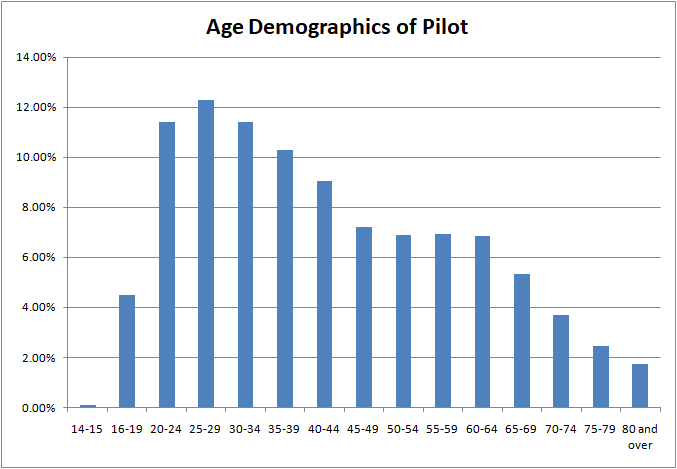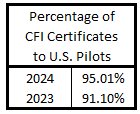I always find a few just, quirky, curious data points every year when I dig through the data on airman certification. Some of these are just data points that I found interesting or ones that I think might illustrate something curious, at least for me.
I hope you find them equally interesting!
Total of 848,770 airmen certifications held. This is the total number of all airmen certificates that are held in the the national airspace system that the FAA believes are for live people. When you think about that, if we think of this of the total population of the United States (not that every airmen certificate holder is from the United States) at 334,900,000 people roughly according to 2023 numbers, this means that the cool kids (in my opinion as holders of an airmen certificate) represent only 0.253% of people!
Our pilot population is trending younger. When we look at the overall breakdown of our airmen certificate holders ages, the largest percentages of our pilots are not overly senior when it comes to age. As we have continued to create new airmen certificate holders actively in the recent years, we are seeing higher percentages of our pilot population fit the under 40-years old age demographic.

In 2024, we issued 3 recreational pilot certificates. A legacy certificate that is in the regulations yet and possible to be issued, it is rarely used. For those CFI candidates ou there, don’t expect to need to use these regulations very often.
Sport pilot issuances were a little larger number, but still a very small number. 2024 saw 226 initial sport pilot issuances. I bring this one up, because it may be a number than changes in upcoming years. With the potential implementation of MOSAIC (a change that will allow larger aircraft to be flown under sport pilot privelges), there is a potential that this certificate may get more utilization in the upcoming years.
Glider only pilots still remain a limited number of people. Only 175 initial glider certificates were issued in 2024. Most glider pilots still seem to be pilots who also fly other categories/classes of aircraft, and additionally fly gliders.
 Most CFI certificates issued in the United States, are issued to U.S. citizens. While the U.S. is a training location for many non-U.S. citizens for pilots seeking private and commercial certificates, instrument ratings, and multi-engine privileges, most of the CFI certificate training is focused on U.S. citizens. This is likely due to the fact that is more challenging for non-U.S. citizens to work in the U.S. as CFIs after they would complete such training, but also because most of those that are here for pilot training transition back to home countries for additional training or service specifically as professional pilots in airline and cargo operations. The CFI certificate is not needed in many of these environments for those pilots to continue to gain experience to meet experience requirements as it is in the United States where additional hours are required for ATP pilot certification flight operations.
Most CFI certificates issued in the United States, are issued to U.S. citizens. While the U.S. is a training location for many non-U.S. citizens for pilots seeking private and commercial certificates, instrument ratings, and multi-engine privileges, most of the CFI certificate training is focused on U.S. citizens. This is likely due to the fact that is more challenging for non-U.S. citizens to work in the U.S. as CFIs after they would complete such training, but also because most of those that are here for pilot training transition back to home countries for additional training or service specifically as professional pilots in airline and cargo operations. The CFI certificate is not needed in many of these environments for those pilots to continue to gain experience to meet experience requirements as it is in the United States where additional hours are required for ATP pilot certification flight operations.
